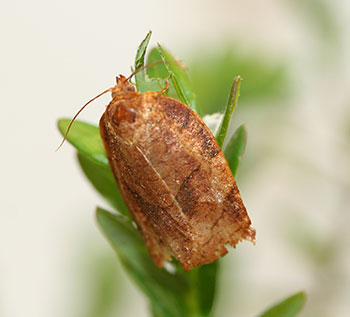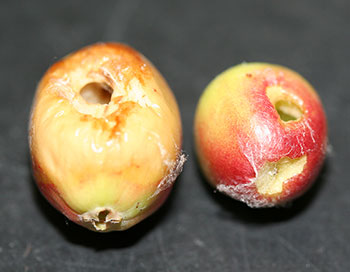Fact Sheet FS1247

Figure 1.
Spotted fireworm, Choristoneura parallela (Robinson) (Lepidoptera: Tortricidae), is an important pest of cranberry in New Jersey. Larvae feed on the leaves and fruit. They are generalists and feed on a wide variety of plants, including loosestrife and marsh St. John's-wort. Females lay their eggs typically on weeds, so keeping beds clean from weeds may keep this insect under control.
Distribution
The insect has been found from Ontario (Canada) to Florida, including Maine, Massachusetts, New Jersey, New York, Illinois, Wisconsin and Minnesota. It has been recorded on cranberry in New Jersey, Massachusetts, Minnesota and Wisconsin. Until the 1980's, spotted fireworm was not considered to be a serious pest of cranberry in any growing region. Since then, the use of sprinkler irrigation systems for frost control allowed growers to remove the winter flood earlier in the season. The resulting extended season enabled spotted fireworm to complete two generations per year, contributing to its pest status in New Jersey.
Life cycle

Figure 2.
Spotted fireworm has two generations a year. Second-instar larvae overwinter on the bog floor and emerge in late April/early May, webbing cranberry uprights together to create feeding spots (Figure 1). Larval development takes about 40 days and the duration of the pupal stage is 8-9 days. First generation adults emerge in early June, second generation adults in mid-August (Figure 2). The eggs hatch in about ten days. Second-generation larvae feed on leaves and berries and diapause as second instars.
Identification
Eggs are laid in flat, shiny masses containing up to 350 eggs. They are circular, flat, and partly overlap one another. Egg masses are predominantly laid on the upper surface of the leaves of weeds. The eggs are lemon yellow at first, later become orange, and when they are close to hatching, the brown heads of the larvae can be seen through the shell. Small larvae are yellowish white with brown heads; larger larvae are olive green with a light reddish brown head and conspicuous white spots along the whole length. Usually, one pale hair rises from each spot (Figure 1). Fully grown larvae are 19 mm (3/4") long. Pupae are chestnut brown, about 13 mm (1/2") long, and can be found among the webbed uprights. Adult moths are 19mm (3/4") in width and are brown with two chocolate-colored stripes crossing each forewing diagonally (Figure 2).
Damage

Figure 3.
In spring, the overwintered, first-generation larvae move to the tips of cranberry uprights and web them together to create feeding spots. When they grow, they pull increasing numbers of uprights together with webbing; full-grown larvae may tie as many as 20 uprights together. High numbers of first-generation larvae can cause serious damage to a cranberry bed, but this rarely happens. Second-generation larvae are a major problem as they feed on the fruit and cause serious crop loss (Figure 3). They hatch during late bloom and also web uprights together; they feed on foliage, but also on the developing fruits. When in high numbers, damage by the insect causes a characteristic browning of the uprights.
Management
Insect presence can be monitored with sweep net sampling. Although we do not have an economic threshold estimated for this insect, populations below an average of 4 mediumsized larvae per 25 sweeps may not require insecticide treatments. The most effective control of spotted fireworm is achieved when larvae are in early stages of development and are not tightly enclosed in leaves or have entered berries. As females lay their eggs mostly on the upper surfaces of the leaves of weeds, the presence of egg masses needs to be monitored on the weeds in and around the beds (red maple, green brier, leatherleaf, loosestrife, red root, St. John's wort, etc.). If eggs are not observed, second-generation larvae should not be a problem. Eradication of weeds may help control the pest.
Spotted fireworm has many parasitoid natural enemies and development of newer, target-specific insecticides with minimal impact on these natural enemies has greatly aided the management of the pest. Two of its most common parasitoids are a braconid wasp, Meteorus trachynotus (Viereck), and an egg parasitoid, Trichogramma minutum (Riley). Parasitized eggs turn black and can be easily distinguished from the yellow-orange unparasitized eggs.
Pheromone trapping of adult male moths is possible, as the sex pheromone has been identified, and a lure is commercially available. Flooding for 30 h in early July may be an effective way to control the insect, although this poses a risk of serious injury to the rapidly growing plants.
Literature cited
- Averill AL, Sylvia MM. 1998. Cranberry insects of the Northeast - A guide to identification, biology and management. University of Massachusetts Extension, Amherst, MA, 112 pp.
- Neal JW Jr, Klun JA, Bierl-Leonhardt BA, Schwarz M. 1982. Female sex pheromone of Choristoneura parallela (Lepidoptera: Tortricidae). Environmental Entomology 11: 893-896.
- Polavarapu S, Lonergan G. 1998. Sex pheromone of the Choristoneura parallela (Lepidoptera: Tortricidae): Components and development of a pheromone lure for population modeling. Environmental Entomology 27: 1242-1249.
- Stuart RJ, Polavarapu S. 1998. Oviposition preferences of the polyphagous moth Choristoneura parallela (Lepidoptera: Tortricidae): Effects of plant species, leaf size, and experimental design. Environmental Entomology 27: 102-109.
- Stuart RJ, Polavarapu S. 2000. Egg-mass variability and differential parasitism of Choristoneura parallela (Lepidoptera: Tortricidae) by endemic Trichogramma minutum (Hymenoptera: Trichogrammatidae). Annals of the Entomological Society of America 93: 1076-1084.
Photo credits: Elvira de Lange, Department of Entomology, Rutgers University
November 2015
Copyright © 2024 Rutgers, The State University of New Jersey. All rights reserved.
For more information: njaes.rutgers.edu.
Cooperating Agencies: Rutgers, The State University of New Jersey, U.S. Department of Agriculture, and Boards of County Commissioners. Rutgers Cooperative Extension, a unit of the Rutgers New Jersey Agricultural Experiment Station, is an equal opportunity program provider and employer.

